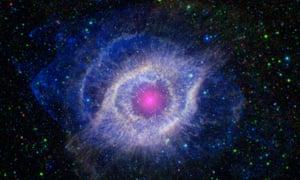You wait 100 years for a gravitational wave and then four come along
at once. Or so it must seem to those who spent decades designing and
building the exquisite instruments needed to sense the minuscule ripples
in spacetime that Albert Einstein foresaw in his 1905 theory of general
relativity.
The first gravitational wave bagged by physicists reached Earth on 14 September 2015 and sent a quiver through the US-based Laser Interferometer Gravitational-Wave Observatory (Ligo). The second hit three months later, on Boxing Day, followed by a third in January this year. When the fourth wave arrived in August, both Ligo and a second observatory in Italy, named Virgo, recorded the moment.
Each of the gravitational waves had been set in motion by violent collisions between black holes more than a billion years ago. But while detecting the waves was feat enough to land the Nobel prize in physics for Rainer Weiss, Barry Barish and Kip Thorne, what excites astronomers now is what they stand to learn about the universe.
“This is a story in two parts,” said Sheila Rowan, director of the
Institute for Gravitational Research at the University of Glasgow. “The
first part was the quest to make these instruments sensitive enough to
make the first detection, but that’s the end of one story and the start
of another. We are really on the threshold of a whole new way to study
our universe and that’s hugely exciting.”The first gravitational wave bagged by physicists reached Earth on 14 September 2015 and sent a quiver through the US-based Laser Interferometer Gravitational-Wave Observatory (Ligo). The second hit three months later, on Boxing Day, followed by a third in January this year. When the fourth wave arrived in August, both Ligo and a second observatory in Italy, named Virgo, recorded the moment.
Each of the gravitational waves had been set in motion by violent collisions between black holes more than a billion years ago. But while detecting the waves was feat enough to land the Nobel prize in physics for Rainer Weiss, Barry Barish and Kip Thorne, what excites astronomers now is what they stand to learn about the universe.
Until now, astronomers have mapped the heavens almost exclusively with telescopes that gather light and other forms of electromagnetic radiation. Optical telescopes, such as Hubble, have allowed scientists to gaze deep into the history of the universe, but these observations hit a hard limit at about 400,000 years after the big bang: back then, the universe was opaque to light.
“At some point, not with the detectors we have now, we hope to be able to look at the beginnings of the universe,” said Rainer Weiss, the physicist at MIT who shared Tuesday’s Nobel prize in physics with other members of the Ligo team.
“There are calculations that indicate that the very earliest instants of the universe, right after the universe gets born, there is an enormous amount of background radiation of gravitational waves generated. That would be one of the most fascinating things man could [see] because it will tell you very much how the universe starts.”
Why discovering gravitational waves was a big deal – video
Professor Andreas Freise, a Ligo project scientist at the University of Birmingham, said: “One of the mysteries is how we get from there to now where everything is clumpy.”
The transition is thought to have left a gravitational wave imprint on the entire universe, which might be visible with future detectors more sensitive than Ligo.
There are plenty more phenomena scientists hope to spot sooner. Gravitational waves spread out from cosmic events that accelerate huge quantities of matter. This happens when a star explodes, but until now, all astronomers have seen is the bright flash of light that marks a star’s death. By studying gravitational waves, scientists hope to learn for the first time what happens inside a collapsing star.
“It should produce a gravitational wave signal and it’s a signal that would give us information that currently we can’t get any other way, because it’s about what’s happening inside a collapsing star,” Rowan said.
When Ligo switched on, scientists thought that the first waves they spotted were likely to come from collisions between neutron stars, some of the most exotic entities in the universe. Neutron stars form when massive stars die. They have crusts and crystalline cores and are incredibly dense: a teaspoon of neutron star weighs as much as Mount Everest.
“Some supernovae explode and end up as black holes, but others end up as neutron stars,” said Pedro Ferreira, professor of astrophysics at Oxford University and author of the 2014 book The Perfect Theory: a century of geniuses and the battle over general relativity. “The thing the Ligo scientists expected to see, and might see soon, are two neutron stars orbiting each other and coming together. If you can see these events you start learning about fundamental physics, and that is pretty amazing.”
Other countries, including Japan and India, have plans to build their own gravitational wave detectors. More ambitiously, the European Space Agency intends to send an observatory into space in 2034. Known as Lisa, for Laser Interferometer Space Antenna, the mission aims to detect far weaker gravitational waves than is possible on Earth.
“Many of us who were in this thing fully expect that we’re going to learn things that we didn’t know about,” said Weiss. “We knew about black holes other ways, and we knew about neutron stars. We hope that there are all sorts of phenomena that you can see mostly because of the gravitational waves they emit. That will open a new science.”

No comments:
Post a Comment